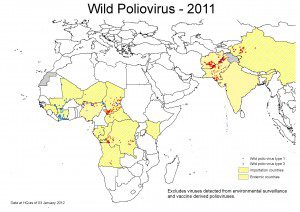

This achievement represents a remarkable turnaround for India, where control of the disease had for years been extremely difficult. As recently as 2009 there were 741 confirmed cases of polio caused by wild-type virus (as opposed to vaccine-derived virus) in India. The tide turned in 2010 with only 42 confirmed polio cases, and in calendar year 2011 there was just one. That is why the 2011 map marking locations of confirmed wild polio cases in India (see figure) shows only one red dot (paralysis caused by type 1 poliovirus) in the country. The blue dots indicate cases caused by type 3 poliovirus.
The challenge now is to keep India free of polio. The map shows why this will be difficult – there are many red dots (cases of type 1 polio) in neighboring Pakistan and Afghanistan. Poliovirus does not respect national borders – China had been free of polio since 1999, but now there are red dots in that country. That outbreak was imported from Pakistan. Even the polio cases in more distant countries such as Africa constitute a threat. As long as there is polio somewhere, all countries must maintain extensive immunization programs. Whether or not that will happen depends upon money, determination, and allowing immunization campaigns to proceed without interruption.
Once polio was eradicated from the United States, the only poliomyelitis was caused by the Sabin vaccine. Consequently this country switched to the use of inactivated vaccine in 2000. As other countries eliminate the disease, vaccine-associated poliomyelitis will become more prominent. If eradication of polio is achieved, the world will have to switch to using inactivated poliovaccine.
Related:
Wild poliovirus in China
Dreaming of inactivated poliovaccine
Poliomyelitis after a twelve year incubation period
Poliovirus vaccine litigation

How will India’s polio free year impact other countries that have endemic infection? Was India a big exporter Afghanistan or Pakistan, for example? Will we thus see a drop in those areas?
In the past ten years Indian wild polioviruses were exported to several other countries in the past, including Angola, Lebanon, Tajikstan, Bangladesh, and Namibia, causing multiple outbreaks. We won’t see more exportations from India, but because the virus is established elsewhere, it could easily return to India.
I find it sad that the world still uses a live attenuated vaccine that can easily revert to pathogenicity, when modern technology would allow us to very easily make an attenuated virus that could not revert. Moving to the killed/inactivated virus requires a series of injections, whereas the live attenuated virus is a one-time oral dose. The reasons for using the current live-attenuated virus which can easily revert to the pathogenic form, have to do with rules, regulations and politics and not science or technology.
It has been an issue for years. WHO says it can’t afford the inactivated vaccine, but if production had been ramped up years ago, it would have been cheaper. I suggested that we switch to IPV back in 2001. DA Henderson (who is now a bioterror fear monger) said I was ‘dreaming’. Now WHO says they *will* switch to IPV. See https://virology.ws/2009/02/26/dreaming-inactivated-poliovirus-vaccine/
Pingback: Contagions Round-up 20: Past is Prologue in Science too! « Contagions
Pingback: World Polio Day
Pingback: India has been free of polio for three years